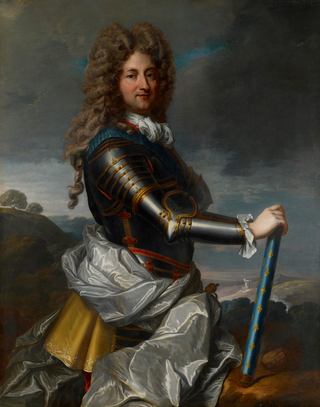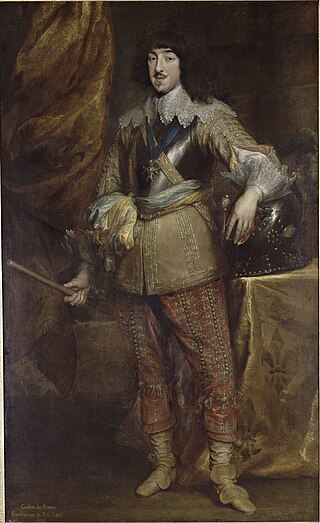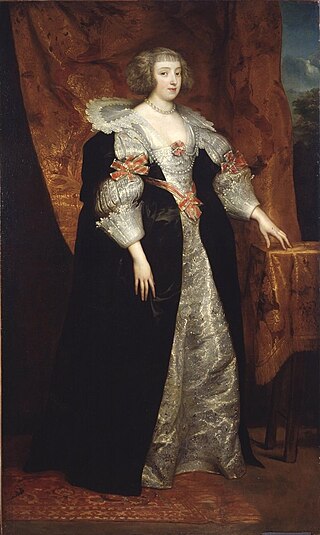
Philippe II, Duke of Orléans, was a French prince, soldier, and statesman who served as Regent of the Kingdom of France from 1715 to 1723. He is referred to in French as le Régent. He was the son of Monsieur Philippe I, Duke of Orleans, and Madame Elisabeth Charlotte, Duchess of Orléans. Born at his father's palace at Saint-Cloud, he was known from birth by the title of Duke of Chartres.

MonsieurGaston, Duke of Orléans, was the third son of King Henry IV of France and his second wife, Marie de' Medici. As a son of the king, he was born a Fils de France. He later acquired the title Duke of Orléans, by which he was generally known during his adulthood. As the eldest surviving brother of King Louis XIII, he was known at court by the traditional honorific Monsieur.
Count of Guise and Duke of Guise were titles in the French nobility.

Charles of France, Duke of Berry, was a grandson of Louis XIV of France. Although he was only a grandson of Louis XIV, Berry held the rank of fils de France, rather than petit-fils de France, as the son of the Dauphin, heir apparent to the throne. The Duke of Berry was for seven years (1700–1707) heir presumptive to the throne of Spain, until his elder brother Philip V of Spain fathered a son in 1707.

François Joseph de Lorraine, Duke of Guise, Duke of Alençon and Duke of Angoulême, was the only son of Louis Joseph de Lorraine, Duke of Guise and Élisabeth Marguerite d'Orléans, suo jure duchess of Alençon.

Princess Marie Isabelle of Orléans was born an infanta of Spain and a Princess of Orléans and became the Countess of Paris by marriage.

Françoise d'Alençon was the eldest daughter of René of Alençon and Margaret of Lorraine, and the younger sister and despoiled heiress of Charles IV, Duke of Alençon.

Marguerite Louise d'Orléans was a French princess who became grand duchess of Tuscany as the wife of Grand Duke Cosimo III de' Medici.

Louise Élisabeth, Duchess of Berry was Duchess of Berry by marriage to the French prince Charles, Duke of Berry. She is known affectionately by the moniker "Joufflotte".

A prince du sang or prince of the blood is a person legitimately descended in male line from a sovereign. The female equivalent is princess of the blood, being applied to the daughter of a prince of the blood. The most prominent examples include members of the French royal line, but the term prince of the blood has been used in other families more generally, for example among the British royal family and when referring to the Shinnōke in Japan.

Marguerite of Lorraine, Duchess of Orléans, was the wife of Gaston, younger brother of Louis XIII of France. As Gaston had married her in secret in defiance of the King, Louis had their marriage nullified when it became known. On his deathbed, Louis permitted them to marry. After their remarriage, Marguerite and Gaston had five children. She was the stepmother of La Grande Mademoiselle.

Marie de Lorraine was the daughter of Charles de Lorraine, Duke of Guise and Henriette Catherine de Joyeuse and the last member of the House of Guise, a branch of the House of Lorraine.

Françoise Madeleine d'Orléans was born a Princess of France and was the Duchess of Savoy as the first wife of Charles Emmanuel II. She was a first cousin of Louis XIV as well of her husband. She was the shortest-serving Savoyard consort, dying at the age of fifteen, childless.

The Royal Chapel of Dreux situated in Dreux, France, is the traditional burial place of members of the House of Orléans. It is an important early building in the French adoption of Gothic Revival architecture, despite being topped by a dome. Starting in 1828, Alexandre Brogniart, director of the Sèvres porcelain manufactory, produced fired-enamel paintings on large panes of plate glass for King Louis-Philippe, an important early French commission in Gothic Revival taste, preceded mainly by some Gothic features in a few jardins paysagers.
The Viscounty of Joyeuse was elevated to a Duchy in 1581 by King Henry III of France for his favourite Anne de Joyeuse.

Jean Gaston d'Orléans, petit-fils de France, Duke of Valois was a French Prince and Grandson of France. He was a member of the House of Bourbon.
Marie Anne d'Orléans, petite-fille de France was a French Princess and youngest daughter of Gaston d'Orléans. She held the rank of Grand daughter of France. She was a member of the House of Orléans.

Élisabeth of Lorraine was a French noblewoman and the Princess of Epinoy by marriage. She is often styled as the princesse de Lillebonne. She was the mother of Louis de Melun, Duke of Joyeuse and of Anne Julie de Melun, princesse de Soubise.

Louis Joseph de LorraineDuke of Guise and Duke of Angoulême, was the only son of Louis, Duke of Joyeuse and Marie Françoise de Valois, the only daughter of Louis-Emmanuel d'Angoulême, Count of Alès, Governor of Provence and son of Charles de Valois Duke of Angoulême, a bastard of Charles IX of France.

















